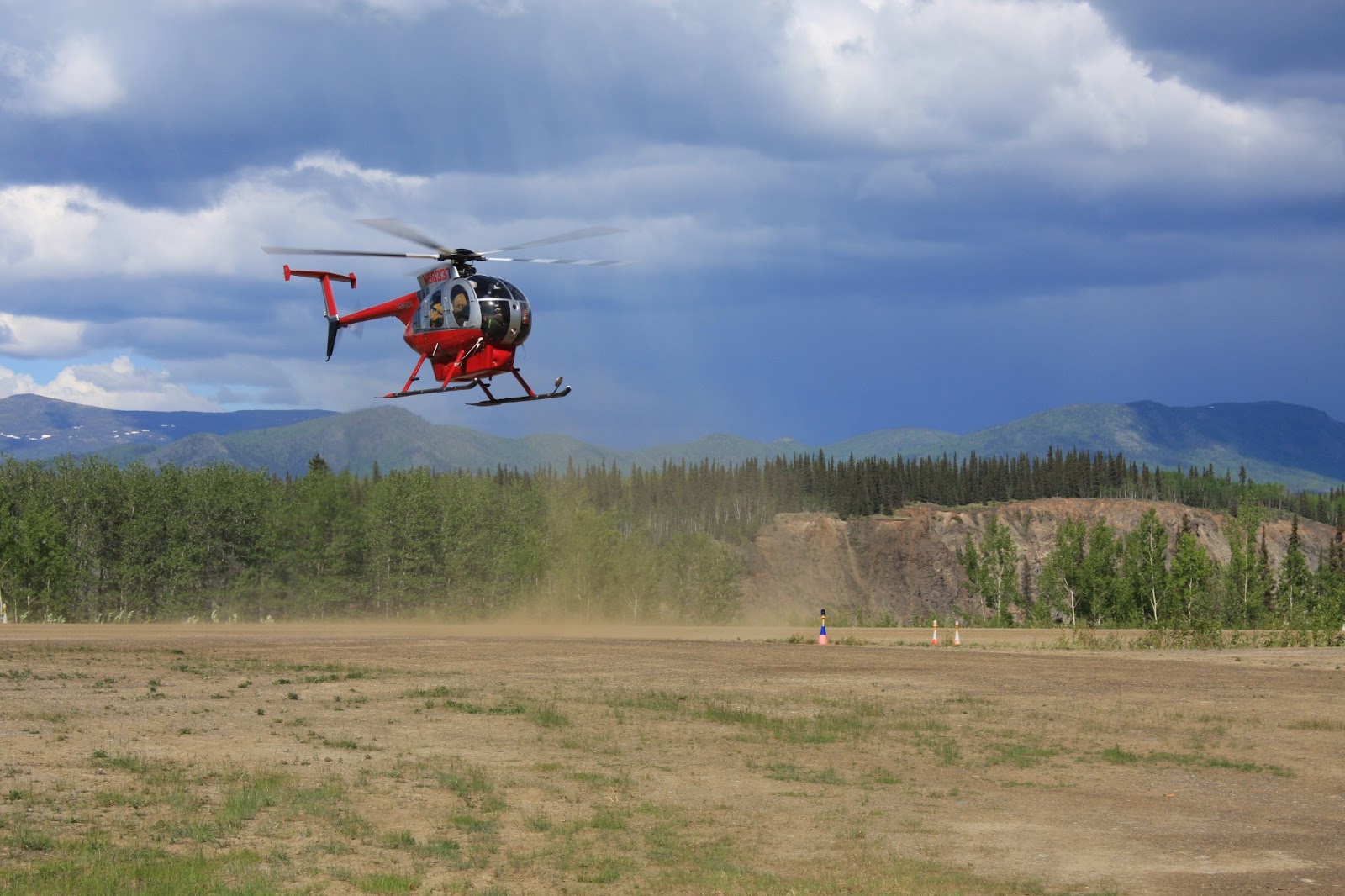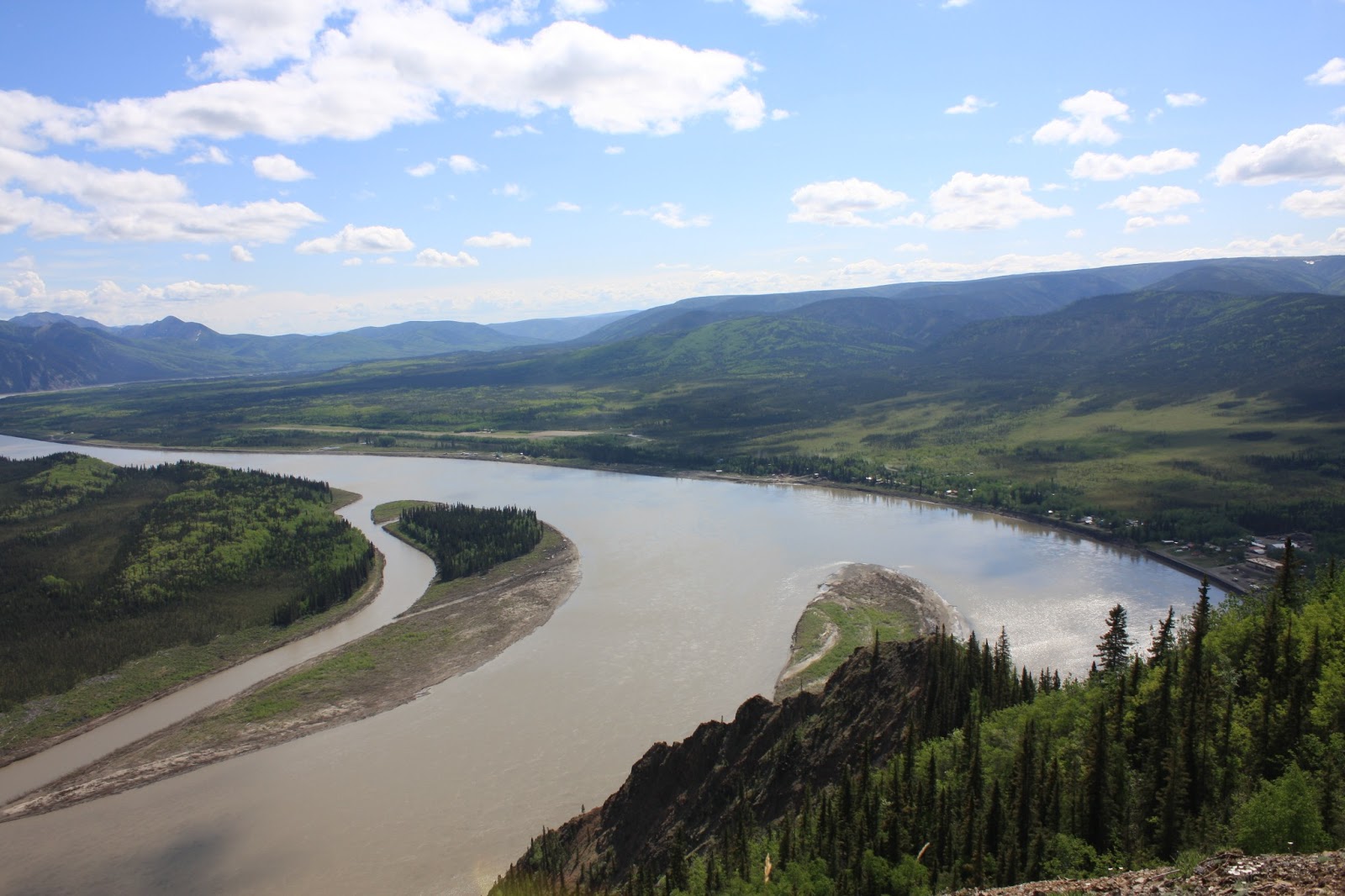The first part of the trip consisted of my first ever helicopter ride. A small helicopter ended up having to make two runs in order to get the three members of our crew and all our surveying gear out to the bush. This provided me with the chance to get a great spot against one of the bubble windows. If you have never been on a helicopter before it is something that is rather difficult to describe. All your senses expect the aircraft to function as an airplane....but then it takes off straight upwards.
A few aerial shots I got during our ride. The freedom of the helicopter also allowed the pilot to strafe subalpine meadows, wind through canyons below the ridgeline, and even enter Canada for minute by accident!
The mighty Yukon River winds its way through Yukon Charley Rivers National Preserve with Montauk Bluff in the background.
Cutting through one of the many super steep and rocky drainages I caught this picture. If you look very closely you can spot a Dall sheep ram about halfway down the thin gravel slope in the middle of the photo.
Brian Howard, one of my fellow crew members, and myself were flown out first as our team leader, Fleur, had not arrived in Eagle from Fairbanks via single-prop plane. Brian and I pointed out the saddle between the two ridges on which we had planned to camp and within a minute our pilot had set us down. No taxiing, no waiting to unload, or circling in the air...just going wherever we wanted to. The moment it really hit me that I was out in the Alaskan wilderness was after we had unloaded our gear and the pilot hopped back in the heli and disappeared down the valley.
This photo is from about halfway up towards the ridge along Nimrod Peak where we had to put in temperature sensors. The steepness of the slopes (commonly between 40-45 degrees), looseness of the rocks, thickness of brush, heat, mosquitos, and heft of our packs (40-50lbs each) made hiking between plots unbelievable tiring. To reach some plots a mere 500m away it could take over an hour. This made for some very long days where we would hike out at 8 in the morning and return past 9 in the evening.
On a blustery, and particularly exhausting, day I snapped this photo of the Yukon River in the background between thunderheads and sunny skies...typical Alaska.
Fleur and Brian analyze the placement of a soil temperature gauge placed along part of the Squaw Mountain ridge.
A view back along the Squaw ridge. With really only one day exception, the weather the entire trip was magnificent, if not a little warm.
The slopes were dominated by gigantic spires of rock which gave a spectacularly forlorn, yet beautiful, appearance to many of the areas we hiked.
Following the ridge one day down Squaw Mountain we spotted a grizzly bear (brown, mid-left) wander out onto the plateau we had planned on using to reach our next plot. As Brian put it, it was a "wilderness traffic jam" as we stopped for an early lunch and waited for the bear to exit the immediate area. Before doing so though a second bear (black bear, upper right) also emerged and prolonged our continuance down the slope. Once they both had sauntered over to the left margins of the bluff we were able to continue on our way.
The skies at midnight...that's right. Nothing like waking up at 3:30 in the morning to the sun blaring into your tent.
On the way back one evening from work Brian spotted a few morrells which we sauteed up for dinner. Tasty mushrooms with a nutty flavor/aroma, my first time trying them.
Curious bumblebees flitted between flowers almost everywhere we hiked which was a pleasant sight having come up from the lower 48 where their disappearance has lowered the chance of spotting one.
Nameless, hundred foot cliffs would come out of nowhere. Definitely got that feeling of vertigo standing on their edge sometimes. One cliff in particular sticks out in mind, I didn't have my camera with me, but about 10 hours into the work day we were all tired and trying to figure out the best way back to camp (a good 2 hour hike away). We first tried to descend a ridge into the Funnel Creek drainage but a sudden, and dramatic, 300 foot cliff popped out of nowhere and forced us to retrace our steps.
Brian gets a good view of the Harrison Creek watershed and Jones Ridge from a cliff top.
A view towards Harrison Creek.
Fascinating fossils were unbelievably abundant on some slopes. Our last evening we went for a stroll, and on one rock face it seemed as if every pebble, rock, and boulder had at least one fossil.
The last morning as we packed our gear up waiting for the helicopter to arrive around noon I was speaking to Fleur when I noticed movement over her shoulder. I got quite the shock when I realized it was a monstrous grizzly bear that was wandering down a sheep trail directly towards our camp. As we observed the bear, it turned and disappeared down the slope towards the Funnel Creek valley. We thought it was gone...
About fifteen minutes later however I spotted movement only ~30 yards from camp. The gigantic animal had somehow snuck over the ridge without anyone noticing. We made sure our presence was clear to the bear as it meandered through the thick brush, often only the recognizable grizzly shoulder hump visible above the shrubs. Then it took a sniff of the air and stood on its hind legs to look at us. I froze at that moment, and did not take a picture. But the sensations I felt the instant the grizzly bear stood on its hind legs and looked directly at me can hardly be described in words or photos, but undoubtedly left an impression in my mind. I gathered myself quickly and grabbed this shot as he turned and before he fell back to all fours. Within seconds he had run off to the spruce stand in the background. A truly magnificent encounter, and magical way to end my first 10 day trip to the Yukon.




















































































